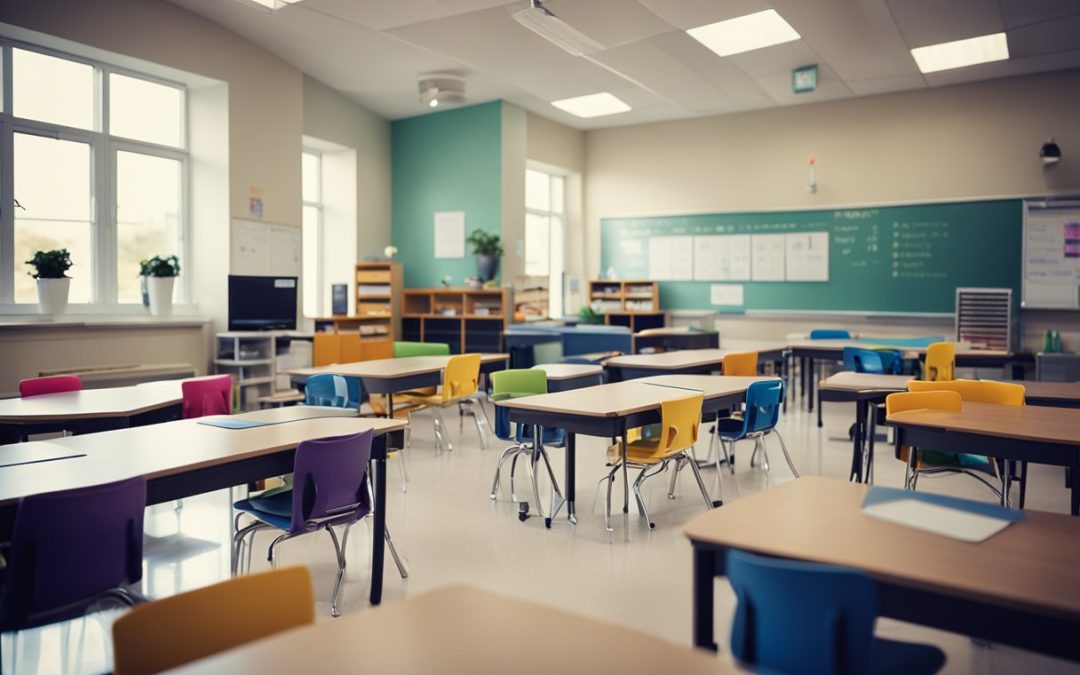Effective communication between parents and schools is fundamental to the success and well-being of students with autism. In our shared journey within the education system, it’s crucial we establish strong, collaborative partnerships. Understanding the unique challenges our kids face, we must create open lines of conversation with educators and support staff.
We recognise that every student on the autism spectrum has individual needs that can be quite distinct from their peers. Tailor-made communication strategies are essential to ensuring that our children are granted the educational opportunities they deserve. By sharing information and working closely with the school, we pave the way for inclusivity and facilitate a learning environment where our children can thrive.
As we navigate this path together, it’s imperative to employ a variety of techniques in our approach. Consistency in dialogue, active listening, and mutual respect lay the foundation for a robust relationship between parents and schools. Armed with these strategies, we bolster the educational support for our kids, fostering an atmosphere that not only recognises but also celebrates their unique contributions to the school community.
Understanding Autism in the School Setting
When we consider the education of children with autism, it’s essential to focus on understanding and fostering an environment that promotes both inclusion and diversity. This approach directly affects the well-being of students and contributes positively to the overall school culture.
Creating an Inclusive Environment
To create an inclusive environment, we need to ensure that our schools are places where every child feels welcome and supported. This begins with tailored training for educators that provides strategies for addressing the needs of autistic children. Practical changes might include:
- Visual aids: Clear, easy-to-understand visuals can help with daily routines and transitions.
- Sensory-friendly spaces: Access to quiet areas can offer a respite from overwhelming sensory input.
- Predictable structures: Establishing consistent routines reduces anxiety and aids learning.
Acknowledging Diversity and Differences
Recognising and embracing the differences among us enriches our school community. Our language and actions should consistently communicate respect for every individual’s unique qualities. Here’s how we can acknowledge diversity and differences:
- Individualised plans: Tailoring learning plans that account for each child’s strengths and challenges.
- Student-centred learning: Engaging methods that put the student’s interests at the forefront.
- Peer education: Teaching all students about autism fosters a culture of understanding and support.
Effective Communication Tactics
Effective communication between parents and schools is paramount, especially when it involves children with autism. It’s our shared goal to ensure these children receive the best support. We’ll explore how technology can enhance our engagement and why incorporating empathy into our conversations is crucial.
Leveraging Technology for Engagement
We’re fortunate to have a host of communication apps at our fingertips, which can profoundly impact our engagement with schools. By utilising these apps, we can:
- Send and receive emails to stay updated on our child’s progress and communicate any concerns quickly.
- Access real-time updates about our child’s day-to-day activities through school-provided platforms.
Here’s a simple table to outline the benefits of popular communication apps:
| App | Use-Case | Benefit |
|---|---|---|
| Seesaw | Sharing student work | Gain insights into daily learning |
| Remind | Messaging | Facilitate timely conversation |
| ClassDojo | Behaviour tracking | Understand behavioural patterns |
When using these technologies, we ensure we maintain a steady stream of dialogue that benefits our kids.
Active Listening and Empathy in Conversation
In every conversation with school staff, active listening and empathy are vital. Here’s how we can practise these:
- Confirm understanding: Paraphrase what’s said to ensure we’ve understood it correctly.
- Respond thoughtfully: Give feedback that shows we’ve considered the speaker’s perspective.
Active listening and empathy deepen our connection with teachers, creating a collaborative atmosphere. By showing teachers that we understand and respect their professional insights, we build stronger partnerships on behalf of our children.
Strengthening Parent-Teacher Partnerships
We know how critical our partnership with teachers is, especially when working together for the well-being of children with autism. Effective communication forms the bedrock of this relationship, and by focusing on regular communication and building trust, we can ensure our kids receive the support they need.
The Role of Regular Communication
Regular communication between us and teachers is vital. It keeps us informed and involved in our children’s educational journey. Here are a few ways to maintain this communication:
-
Scheduled Updates: We can agree upon a schedule for regular updates, which could take the form of written reports, emails, or brief check-ins. This ensures that information regarding our child’s progress is routinely shared.
-
Parent-Teacher Meetings: Setting up recurring face-to-face meetings allows for in-depth discussions about our child’s needs, progress, and any concerns that might arise.
-
Newsletters and Notices: We should read all school newsletters and notices as they often contain information about opportunities for involvement or upcoming events that impact our child.
Building Trust and Rapport
Trust and rapport between us and teachers are the foundation of a successful partnership. Here’s how we can build and maintain it:
-
Open Communication: We aim to share our thoughts and concerns openly but respectfully, demonstrating that we value the teacher’s expertise and point of view.
-
Positive Reinforcement: Acknowledging and showing appreciation for the teacher’s efforts with our child can reinforce a positive and cooperative relationship.
-
Consistency and Respect: Consistently being punctual and prepared for meetings and respecting the teacher’s time goes a long way in showing that we are committed and reliable partners.
Empowering Parents for Direct Involvement
We understand that for our kids with autism to thrive, we need strong partnerships between parents and schools. It’s about ensuring that we, the parents, are actively involved and supported to communicate effectively with educators.
Workshops and Educational Resources
We’ve found that participating in workshops specifically designed for parents of children with autism is incredibly beneficial. These workshops provide us with the latest research, strategies for advocacy, and communication tools tailored to our needs.
Key offerings in workshops include:
- Understanding Autism Spectrum Disorder (ASD): Gaining a deeper insight into how ASD affects learning and socialisation.
- Rights and Responsibilities: Learning about our kids’ legal rights within the education system, and what we can do to ensure they’re met.
- Communication Techniques: Developing skills to effectively express our children’s needs and our expectations with teachers and staff.
Educational resources, such as pamphlets, websites, and online tutorials, also play a crucial role. They offer guidance on how to prepare for meetings, the types of questions to ask, and how to follow up on action items discussed with school staff.
Collaborative Problem-Solving Techniques
Collaborative problem-solving is a cornerstone of effective parent-school interaction. It allows us to work as a team with educators to address any issues our children may face. We focus on creating a plan that caters to our child’s unique needs while fostering a positive learning environment.
Steps in Collaborative Problem-Solving include:
- Identify the Issue: Clearly stating what the problem is from both our perspective and that of the educators.
- Share Insights and Perspectives: Offering insights into our child’s behaviour and learning style, and listening to the staff’s professional observations.
- Generate Solutions: Brainstorming together to find creative and practical strategies that benefit our child academically and socially.
- Agree on a Plan: Deciding on the steps to implement the chosen solutions, ensuring we’re all on the same page.
- Review and Revise: Regularly assessing the effectiveness of the plan and making necessary adjustments.
By utilising these problem-solving techniques, we, as parents, can play an integral and proactive role in our child’s education. It not only empowers us to advocate for our children but also helps build a supportive and understanding relationship with the school.
Measuring and Celebrating Student Outcomes
When we talk about our children’s education, especially for kids with autism, it’s vital to measure and evaluate their academic performance and growth, as well as to celebrate all forms of their achievements.
Assessing Academic Performance and Progress
In understanding how our students are advancing academically, we consider both formal and informal assessments. We often utilise standardised tests to track academic performance. However, we also observe day-to-day progress through:
- Classroom assessments: Teacher-made tests, quizzes, and oral presentations provide immediate feedback on student learning.
- Portfolios: Collections of student work over time showing improvement and depth of understanding.
It’s essential to communicate these outcomes to parents in a clear and comprehensible manner, so we create reports that include easy-to-read tables and charts. Here’s an example:
| Subject | Baseline Score (Start of Year) | Current Score (Most Recent Assessment) | Progress |
|---|---|---|---|
| Mathematics | 62 | 75 | +13 |
| Reading | 70 | 82 | +12 |
| Social Skills | Consistent interactions | Initiated interactions | Improved |
Valuing Achievements Beyond Academics
While academic success is important, we equally celebrate achievements that fall outside the traditional academic spectrum. These often include:
- Social milestones, such as making a new friend or participating in a group activity.
- Personal triumphs like overcoming a sensory challenge or learning a new life skill.
To recognise these victories, we set up an Achievement Board where we showcase every student’s successes, whether they are academic or personal. We believe every step forward is worth acknowledgement, demonstrating to our kids that their efforts are noticed and appreciated. The inclusion of these achievements can often look like:
| Name | Achievement | Date |
|---|---|---|
| Amelia Thompson | Joined school choir | 20 Mar |
| Ethan Williams | Completed a solo project | 15 Mar |
| Leo Robertson | Used public transport independently | 10 Mar |
By measuring and celebrating both the academic and non-academic outcomes, we provide a more holistic view of student progress and success. It’s about giving parents a well-rounded understanding of their child’s development, fostering a partnership between home and school that’s centred on supporting every aspect of our students’ growth.
Addressing Challenges and Building Resilience
As we engage with schools, it’s important we recognise the diverse challenges that arise and remain resilient throughout. Our ability to navigate these hurdles and bounce back from setbacks is crucial in advocating effectively for our kids with autism.
Navigating Cultural and Language Barriers
We often encounter cultural and linguistic differences when communicating with schools. It’s essential that we acknowledge these differences and seek ways to overcome them. Using interpreters or translation services can help ensure that our concerns and our children’s needs are clearly understood. Additionally, familiarising ourselves with the school’s cultural norms can foster mutual respect and smoother interactions.
- Key Strategies:
- Utilise interpreters or translation services
- Learn about the school’s cultural norms
Conflict Resolution and Constructive Feedback
When conflicts arise, we should approach them with a focus on finding solutions. Beginning interactions with positive feedback about the school’s efforts can set a constructive tone. Active listening and expressing our concerns clearly, without assigning blame, can help prevent misunderstandings and move us towards resolving any issues.
- Conflict Resolution Process:
- Start with positive feedback.
- Clearly express specific concerns.
- Actively listen to the school’s perspective.
- Work collaboratively to find a solution.
By maintaining a friendly and positive attitude, we can turn potential conflicts into opportunities for growth and improved collaboration. It’s about building a partnership where both our needs, and the needs of the school, are met through mutual support and motivation.

